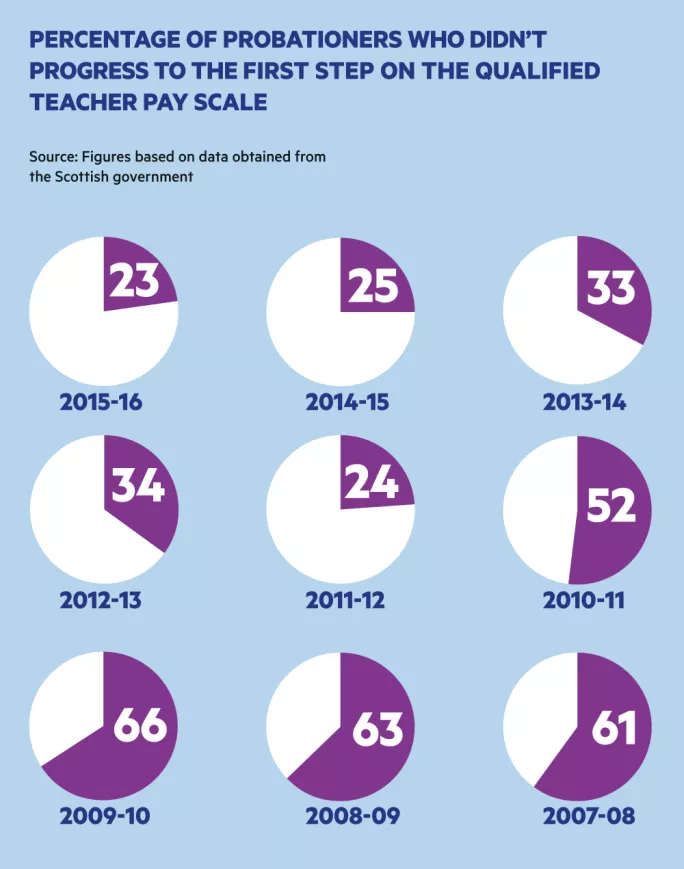Quarter of teachers go AWOL after probation

A huge exodus of new teachers from the profession immediately after their probation year has been revealed in figures obtained by TESS.
The problem, set out in unreported data spanning nine years, is exacerbating the teacher recruitment crisis, unions have warned.
A quarter of teachers being paid as probationers in Scotland in 2015 failed to progress on to the next rung of the pay scale the following year, according to Scottish government data.
In 2015, 2,699 teachers were being paid at the rate received by probationers (point zero on the pay scale) but, in 2016, only 2,069 advanced to claim the salary of a fully fledged teacher at the bottom of the pay scale, known as point one. A total of 630 probationers were therefore unaccounted for last year - about 23 per cent of those at point zero in 2015.
In 2012-13, the figure was even higher, at 34 per cent, but unions claim it was only factored in teacher workforce planning this year. This is denied by the Scottish government.
As a result, hundreds of new staff have left the teaching profession in Scotland without any steps being taken to plug the gaps they have left in classrooms, said Drew Morrice, assistant secretary of Scotland’s biggest teaching union, the EIS.
Between 2014-15, there was a drop of 641 new teachers, or 25 per cent, between the two points on the scale. The previous year saw a decline of 780 teachers, or 33 per cent (see chart, below).

Missed shortages
Mr Morrice, who puts the bulk of the fall down to teachers wanting a break before embarking on their careers, said the problem had “crept up on us” but had not been acknowledged in workforce planning.
Teacher shortages across Scotland led education secretary John Swinney to announce a range of new routes into the profession last year, including fast-tracking new recruits into some secondary subjects suffering acute shortages, such as maths, and attracting unemployed teachers from Ireland.
However, the pay data shows that there needs to be a greater a focus on retaining new teachers once they have attained fully qualified teacher status, said Seamus Searson, general secretary of the Scottish Secondary Teachers’ Association.
Mr Searson said: “Quite a few get disillusioned because they can’t get a permanent position - many are being put on temporary contracts. What we need is not so much getting the numbers up going in but keeping them in once they get through and into the first placement.
“We guarantee a first-year placement but then they have to fight for jobs at the end of that first year.”
‘Unreliable measure’
However, the Scottish government said that pay data was not an appropriate or reliable measure of the retention of new teachers, and the employment rate of probationers had long been part of workforce planning. The most recent figures, published last year, show that 87 per cent of post-probationers had found either permanent or temporary work.
A Scottish government spokeswoman said: “The most accurate information on the number of probationer teachers moving into employment is the Teacher Census, which shows that the percentage of probationers moving into employment is the highest ever, with a significant increase in the number of those probationers securing a permanent post.”
The spokeswoman also added that the figures did not take account of people whose starting salary was higher than point one on the pay scale.
Other explanations for the fall in numbers between the two grades include probationers withdrawing or failing to make the grade during induction. Some may have opted to get their school experience on the flexible route into teaching, which can take up to five years.
Breaks abroad
According to teachers’ watchdog the General Teaching Council for Scotland, probationers on the flexible route would “account for some of the difference in figures”.
However, none of the explanations put forward accounted for the extent of the drop in teacher numbers from one year to the next, argued Mr Morrice. Anecdotally, he said he had heard of some new teachers just wanting a break or to spend time working abroad.
He added: “At one time they might have taken that break between becoming qualified and starting probation, but because of the certainty around the induction scheme, I think people are attracted by that and take the risk later.”
Councils told TESS that probationer retention was high and that there had been a real push to keep hold of new staff in recent years owing to the teacher shortage.
However, the “massive” tax-free salaries on offer in the likes of the United Arab Emirates were also seen as a draw for some new recruits.
Edith Girvan supported probationers in East Dunbartonshire for six years before retiring in the autumn.
She told TESS that she was aware of “many” probationers leaving Scotland for locations such as Dubai and London.
She said: “Many were wanting to use the recognition of GTCS registration to go further afield. Opportunities are sometimes more limited for permanent jobs in Scotland and [probationers] prefer permanency as opposed to working on supply.”
You need a Tes subscription to read this article
Subscribe now to read this article and get other subscriber-only content:
- Unlimited access to all Tes magazine content
- Exclusive subscriber-only stories
- Award-winning email newsletters
Already a subscriber? Log in
You need a subscription to read this article
Subscribe now to read this article and get other subscriber-only content, including:
- Unlimited access to all Tes magazine content
- Exclusive subscriber-only stories
- Award-winning email newsletters